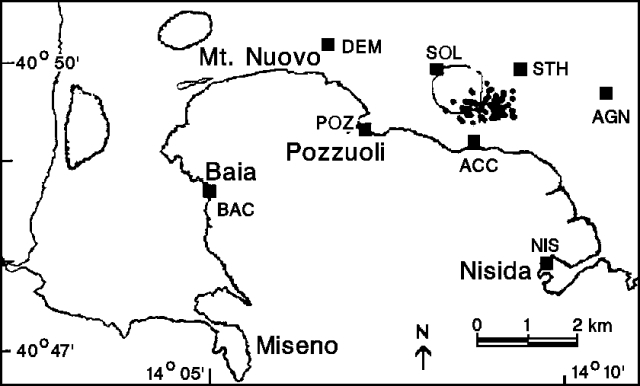Report on Campi Flegrei (Italy) — June 1989
Scientific Event Alert Network Bulletin, vol. 14, no. 6 (June 1989)
Managing Editor: Lindsay McClelland.
Campi Flegrei (Italy) Inflation and seismicity resume after 4-year hiatus
Please cite this report as:
Global Volcanism Program, 1989. Report on Campi Flegrei (Italy) (McClelland, L., ed.). Scientific Event Alert Network Bulletin, 14:6. Smithsonian Institution. https://doi.org/10.5479/si.GVP.SEAN198906-211010
Campi Flegrei
Italy
40.827°N, 14.139°E; summit elev. 458 m
All times are local (unless otherwise noted)
From the beginning of 1985 until the end of 1988, activity . . . was characterized by a generally deflationary trend, but uplift then resumed and a maximum uplift of 7.2 cm was measured in June.
The surveillance network operated by OV consists of eight seismic stations, five tide gauges (four in the Gulf of Pozzuoli, one in Naples for comparison), and four electronic tiltmeters (figure 16). Periodic levelling measurements are made on an extended line and distance measurements are performed twice a year. Radon content and water temperature are monitored in four water wells. Periodic measurements of S/C ratio and water vapor content of fumarolic emissions are made at Solfatara Crater.
Deformation. Vertical motion recorded by the tide gauge in Pozzuoli harbor showed steady deflation until mid-1987 (figure 15). The record then became more oscillatory and some uplift episodes were observed in the general deflationary trend. Figure 15 also shows vertical motion recorded on the levelling line at benchmark 25 (the site of maximum vertical deformation). A steady trend with an average rate of -12.7 mm/month was observed until mid-1987. From then until the beginning of 1989 a decrease in the subsidence rate was observed, and a net uplift of 7.2 cm was measured January-June 1989. Since the end of 1988, four tilt stations have been installed at Campi Flegrei. They are 2-component horizontal pendulum systems with resolutions of 6.9 and 14.5x10-9 rad for the radial and tangential components, respectively. One tiltmeter is in Baia Castle (on the W side of the bay), the other three along an abandoned tunnel roughly 2.5-3.5 km N of Pozzuoli pier. Different trends were observed December 1987-June 1989, showing complex local movement still not fully understood. Two periods of inclination toward the SE were observed, 10 December 1987-12 February 1988 and 22 March-7 April 1988, compatible with deflation of the area of maximum vertical deformation. In other periods the trends were less compatible with this feature, as if the source of deformation had changed its center. Particularly notable was the rotation of the vector after March 1989, indicating an inclination toward the ENE.
Seismicity. No seismic events were observed from 1985 through the beginning of 1987. Since April 1987, several swarms have been observed (figures 17 and 18): 10 April 1987, 50 events, maximum M 2, W sector of Solfatara; 4 November 1987, 26 events, maximum M 1.1, E sector of Solfatara; March 1989, 15 events, Solfatara area; 3 April 1989, 82 events, maximum M 2.2, Solfatara; May 1989, 33 events, maximum M 2.2, Solfatara; 1-13 June 1989, 45 events, maximum M 2.7. Most notable was the occurrence of several low-frequency events, the first time that such events have been observed. They were generally shallow and on the E border of Solfatara crater.
 |
Figure 17. Seismic stations (large squares) and March-June 1989 earthquake epicenters (diamonds) in the Campi Flegrei area. |
Chemistry. The Costagliola well near Monte Nuovo has shown a clear increase in average radon content superimposed on annual variations. A similar trend is apparent for radon contents measured in water wells in different parts of Campi Flegrei. Both the S/C ratio and the water vapor content of a fumarole at Solfatara showed a steady increase starting in mid-1986.
Geologists noted that "All of these data seem to indicate a progressive change in the style of activity . . . , and it seems that the steady deflationary trend has come to an end. We still do not know if the picture we have described is the precursor of a new prolonged uplift phase, or if it represents the restoration of a trend similar to that after the 1970-72 uplift episode, characterized by oscillatory activity until 1982. It is notable, however, that Campi Flegrei is displaying in each new episode of unrest a new phenomenon that was not observed in the previous one. In 1970-72 there was a major uplift without significant seismic activity, and in 1982-84 there was uplift accompanied by seismic activity. In this case, although we still do not know if a sustained uplift will occur, there is the occurrence of low-frequency seismic events."
Further Reference. Tedesco, D., Bottiglieri, L., and Pece,R., 1988, 10th of April 1987 seismic swarm; correlation with geochemical parameters in Campi Flegrei Caldera (southern Italy): Geophysical Research Letters, v. 15, p. 661-664.
Geological Summary. Campi Flegrei is a 13-km-wide caldera that encompasses part of Naples and extends to the south beneath the Gulf of Pozzuoli. Episodes of significant uplift and subsidence within the dominantly trachytic caldera have occurred since Roman times. The earliest known eruptive products are dated 47,000 years BP. The caldera formed following two large explosive eruptions, the massive Campanian ignimbrite about 36,000 BP, and the over 40 km3 Neapolitan Yellow Tuff (NYT) about 15,000 BP. Following eruption of the NYT a large number of eruptions originated from widely scattered subaerial and submarine vents. Most activity occurred during three intervals: 15,000-9,500, 8,600-8,200, and 4,800-3,800 BP. The latest eruption were in 1158 CE at Solfatara and activity in 1538 CE that formed the Monte Nuovo cinder cone.
Information Contacts: G. Luongo, C. Del Gaudio, F. Obrizzo, G. Ricciardi, and D. Tedesco, OV; R. Pece and R. Scandone, Univ di Napoli.



